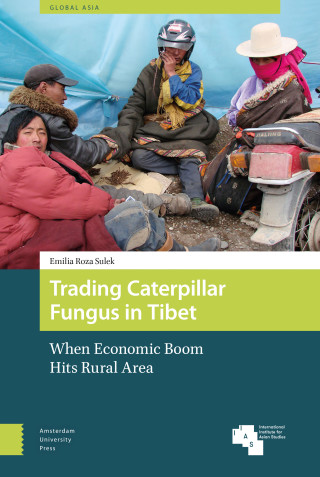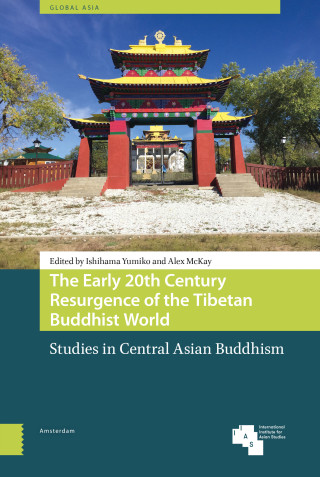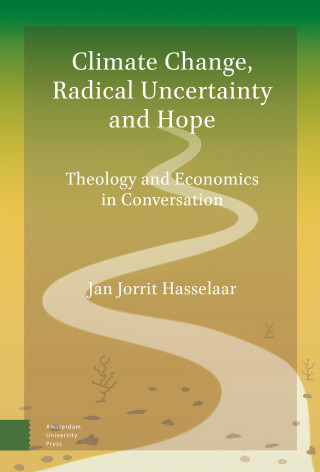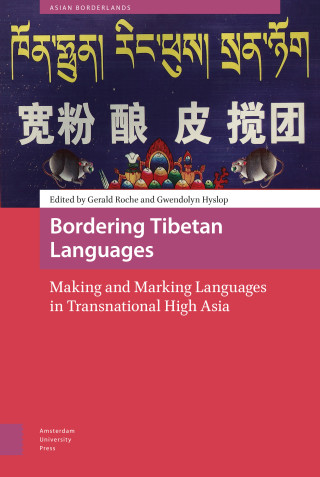
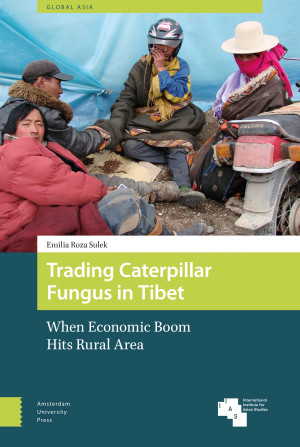
- Title
- Trading Caterpillar Fungus in Tibet
- Subtitle
- When Economic Boom Hits Rural Area
- Author
- Emilia Roza Sulek
- Price
- € 140,99
- ISBN
- 9789048536290
- Format
- eBook PDF (Adobe DRM)
- Number of pages
- 328
- Language
- English
- Publication date
- 15 - 07 - 2019
- Dimensions
- 15.6 x 23.4 cm
- Series
- Global Asia
- Partner

- Discipline
- Asian Studies
- Preview
- Download Preview
- Also available as
- Hardback - € 141,00
Acknowledgements
Note on Transliteration
List of Illustrations
List of Abbreviations
List of Measurement and Currency Units
Introduction
1. Golok: People and Places
2. Digging
3. Fungus, Medicine, Commodity
4. Market and Traders
5. Market Operations
6. The Law in Action
7. Money
8. Pastoral Life and the Market
9. Spending the Money
Conclusions
Afterword: A Note on Methodology
Appendix
Notes
Tibetan Word List
Bibliography
Index
Reviews and Features
"This book is not only an illuminating piece of work for undergraduate and graduate courses on Central and East Asia, but also offers a comprehensive case study for courses in economic anthropology."
- Anne Kukuczka, Journal of the Swiss Anthropological Association, 2021
"The book is a valuable addition to the literature on the caterpillar fungus. It contributes to our knowledge of development, pastoralism, and environmental resources. In particular, it constitutes valuable reading for the wider circles of researchers and students interested in livelihoods and high-value environmental products, as it shares rare details of socioeconomic transformation processes."
- Carsten Smith-Hall, Mountain Research and Development, August 2021
"Emilia Sulek offers unique, first-hand insights into recent modern life and local perspectives on sociocultural, economic, and environmental matters in the heart of the Tibetan Plateau. [...] This book is recommended not only to researchers, but also senior students, environmental and development practitioners, and a wide interested public."
- J. Marc Foggin, China Information 35 (1)
"This book is a precious example of the scholarly value of long-term ethnographic engagement with China’s western regions, a part of the world where such engagement is increasingly fraught with difficulty. It will be of great use not just to those interested in Inner Asia, but also to a wider readership of students and scholars of development, pastoralism and resource extraction."
- Thomas White, Inner Asia, 22 (2020)
"Sulek’s book is clearly written, even sensual. The author has a gift for descriptions of nature, somewhat reminiscent of Hayao Miyazaki films. [...] Sulek spends months on end living with and picking yartsa [caterpillar fungus] with families, providing us with rich, micro-level descriptions of pastoralist life, and pinpointing where the various flows of money are going. [...] This is a captivating and enjoyable book to read in its entirety."
- Tina Harris, newbooks.asia, 2020
"Trading Caterpillar Fungus in Tibet is an important book, shedding light on a phenomenon that has had great impact on the economy and social life in eastern Tibet. [...] Not only anthropologists active in the study of Tibetan society but anyone interested in contemporary Tibet should read this well-written and well-researched book."
- Per Kværne, Asian Ethnology 79 (1)
"Sulek's monograph is an unique and remarkable contribution to the anthropology of Tibet, to regional studies of current China and Central Asia and to economic anthropology at large. It will serve well in undergraduate and graduate classes through its accessible language that gives insight into the economic and social mechanisms set in motion when a new form of income becomes available in a rural, formely poor region."
- Lilian Iselin, The China Quarterly 1-2, 2020
"This monograph is an excellent and important comprehensive study of the caterpillar fungus phenomenon in Tibetan areas such as Qinghai."
- Melvyn C. Goldstein, Nomadic Peoples, 2019
"A comprehensive, delightfully readable and insightful ethnographic account of the highly significant harvest and trade of caterpillar fungus, and its role in the rapid socioeconomic transformation of the Tibetan region of Golok. It is an impressive achievement."
- Emily T. Yeh, University of Colorado Boulder
"This excellent study of Tibetan pastoralism by one of the best young scholars is a must read for all interested in the changing and controversial world of pastoralists in China."
- Melvyn C. Goldstein, Case Western Reserve University
"A significant contribution to both the anthropology of Tibet and studies of modern China."
- Toni Huber, Humboldt University of Berlin
- Anne Kukuczka, Journal of the Swiss Anthropological Association, 2021
"The book is a valuable addition to the literature on the caterpillar fungus. It contributes to our knowledge of development, pastoralism, and environmental resources. In particular, it constitutes valuable reading for the wider circles of researchers and students interested in livelihoods and high-value environmental products, as it shares rare details of socioeconomic transformation processes."
- Carsten Smith-Hall, Mountain Research and Development, August 2021
"Emilia Sulek offers unique, first-hand insights into recent modern life and local perspectives on sociocultural, economic, and environmental matters in the heart of the Tibetan Plateau. [...] This book is recommended not only to researchers, but also senior students, environmental and development practitioners, and a wide interested public."
- J. Marc Foggin, China Information 35 (1)
"This book is a precious example of the scholarly value of long-term ethnographic engagement with China’s western regions, a part of the world where such engagement is increasingly fraught with difficulty. It will be of great use not just to those interested in Inner Asia, but also to a wider readership of students and scholars of development, pastoralism and resource extraction."
- Thomas White, Inner Asia, 22 (2020)
"Sulek’s book is clearly written, even sensual. The author has a gift for descriptions of nature, somewhat reminiscent of Hayao Miyazaki films. [...] Sulek spends months on end living with and picking yartsa [caterpillar fungus] with families, providing us with rich, micro-level descriptions of pastoralist life, and pinpointing where the various flows of money are going. [...] This is a captivating and enjoyable book to read in its entirety."
- Tina Harris, newbooks.asia, 2020
"Trading Caterpillar Fungus in Tibet is an important book, shedding light on a phenomenon that has had great impact on the economy and social life in eastern Tibet. [...] Not only anthropologists active in the study of Tibetan society but anyone interested in contemporary Tibet should read this well-written and well-researched book."
- Per Kværne, Asian Ethnology 79 (1)
"Sulek's monograph is an unique and remarkable contribution to the anthropology of Tibet, to regional studies of current China and Central Asia and to economic anthropology at large. It will serve well in undergraduate and graduate classes through its accessible language that gives insight into the economic and social mechanisms set in motion when a new form of income becomes available in a rural, formely poor region."
- Lilian Iselin, The China Quarterly 1-2, 2020
"This monograph is an excellent and important comprehensive study of the caterpillar fungus phenomenon in Tibetan areas such as Qinghai."
- Melvyn C. Goldstein, Nomadic Peoples, 2019
"A comprehensive, delightfully readable and insightful ethnographic account of the highly significant harvest and trade of caterpillar fungus, and its role in the rapid socioeconomic transformation of the Tibetan region of Golok. It is an impressive achievement."
- Emily T. Yeh, University of Colorado Boulder
"This excellent study of Tibetan pastoralism by one of the best young scholars is a must read for all interested in the changing and controversial world of pastoralists in China."
- Melvyn C. Goldstein, Case Western Reserve University
"A significant contribution to both the anthropology of Tibet and studies of modern China."
- Toni Huber, Humboldt University of Berlin
Emilia Roza Sulek
Trading Caterpillar Fungus in Tibet
When Economic Boom Hits Rural Area
When the demand for, and prices of caterpillar fungus (Ophiocordyceps sinensis, ‘the Himalayan Viagra’, long a part of traditional Chinese medicine) soared, the pastoralists of Golok on the Tibetan plateau where the fungus is endemic dug up, dried and sold the fungus to traders. In the process, these yak and sheep farmers, used to living on the edge of subsistence, became wealthy beyond their imagination. Trading Caterpillar Fungus in Tibet: When Economic Boom Hits Rural Area tells the story of what they do with the money they earned from gathering and trading caterpillar fungus, and what this money does to them, revealing a sophistication few outsiders would credit them for.
Author
Emilia Roza Sulek
Emilia Roza Sulek is an anthropologist of China, Tibet and Central Asia. She writes about shadow economies, development, conflicts over natural resources, state power, and gender politics. She teaches at the Universities of Zurich and Bern.

